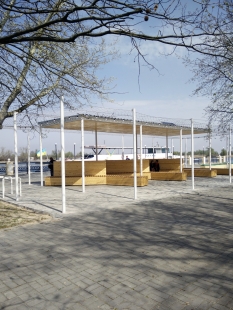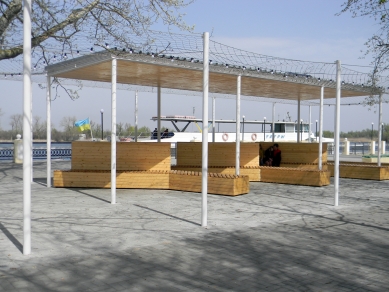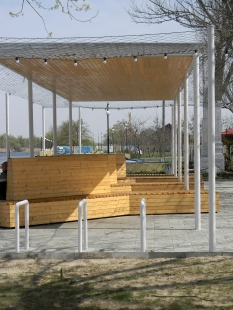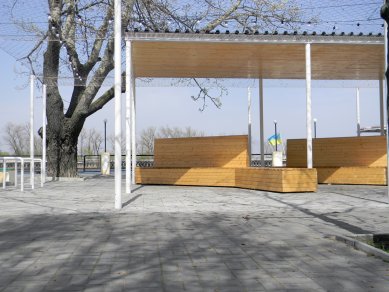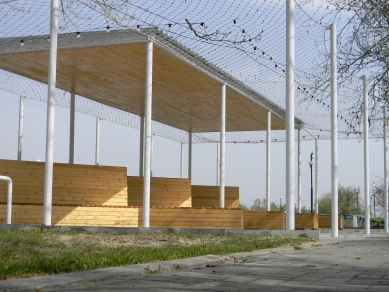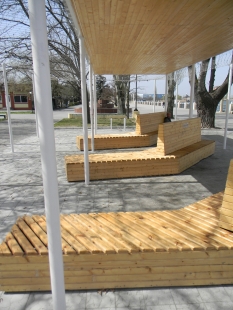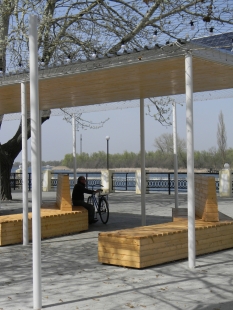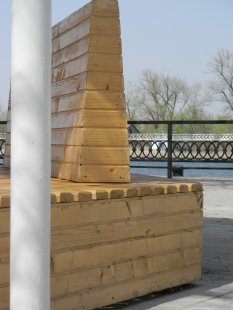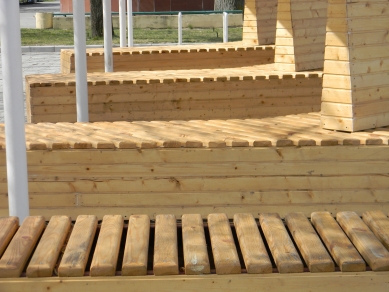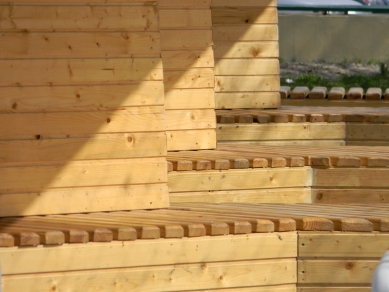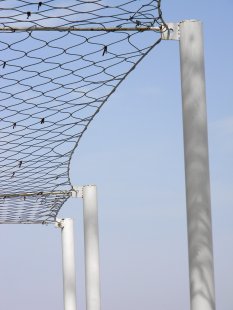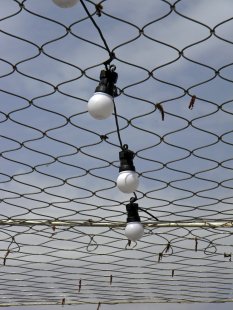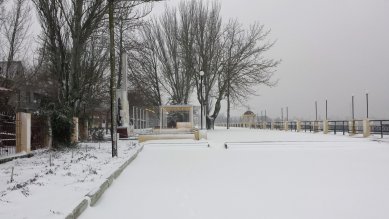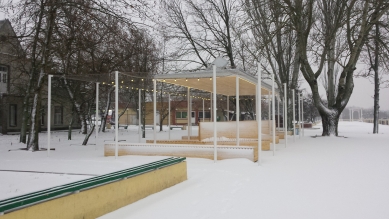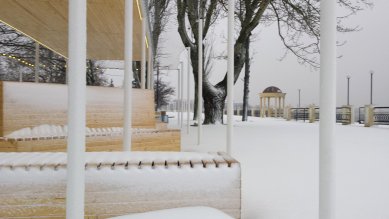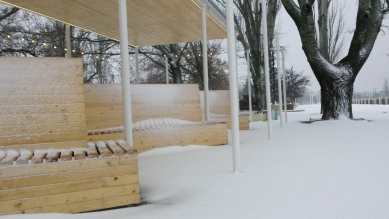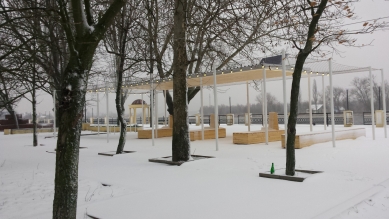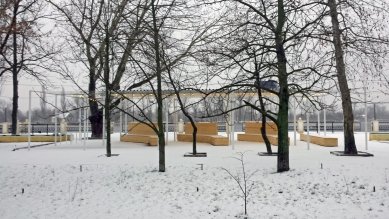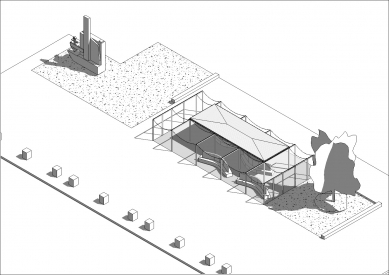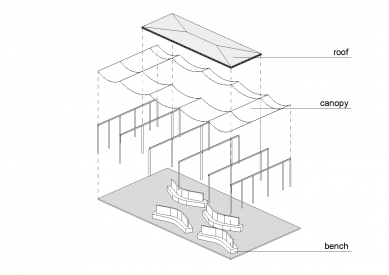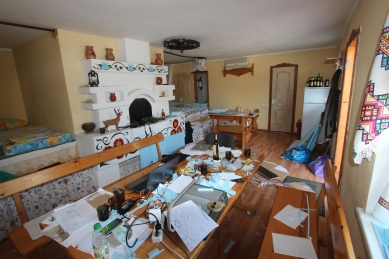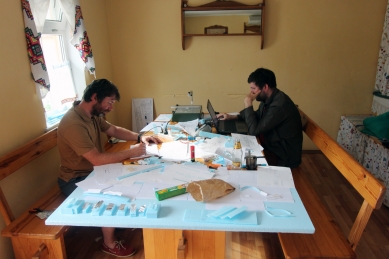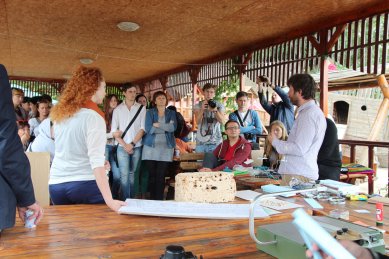
Pavilion on the Dnipro River Embankment

In the early morning, I open the window that my roommate Jirka closed at night to dampen the "frog concert" coming from the river below the window. We are staying at a guesthouse on the outskirts of the town of Gola Prystan in southern Ukraine. Gopri, as the locals abbreviate their town, was built on the bank of one of the river arms in the Dnieper delta. Together, we are participating in an international architectural workshop and designing a small multifunctional pavilion on the riverbank.
The daily program of the workshop is almost holiday-like compared to a typical workday in the Czech Republic. Breakfast starts at nine, and if I were to be late, I would always find something on the table until eleven. I don't know whether the later start to the workday is due to the Polish organizers of the workshop or is a common Ukrainian standard. I would guess it's the first option, as the market in town begins at seven, and from the freshness of the fruits and vegetables, one can deduce they were harvested on the same day they are sold.
After breakfast, our four-member Czech-Polish team of architects sets out to visit the local construction materials store. For the construction we are designing together, we want to use as many materials as are commonly used here. The first stop is the local hobby market, where there are no big surprises. The offer of materials is similar to that in the Czech Republic, perhaps just a bit less varied. An exception, however, is the yellow-brown stone blocks with large pores, in which small shells can sometimes be found. The stone is mined in Crimea, and therefore its price has significantly increased after the Russian annexation. It is used for very diverse constructions. Fences for houses or an Orthodox church rebuilt on the site of one that was destroyed during the revolutionary times of the last century are made from it. As part of our exploration, we still have time to visit a carpentry shop and a hardware store, and then a car with a guide takes us back to the guesthouse for lunch.
The afternoon lunch is traditionally excellent, with plenty of fresh vegetables and a large bottle of liquor on the table. After lunch, we move to our temporary studio, for which our hosts assigned us a small house, a replica of a traditional Ukrainian dwelling with a stove and a thatched roof. Work is going slower than we would like. We still keep returning to the question of where exactly the construction, which is our task to design, should be located. The purpose and function of the building come from a vote by the citizens that took place in the past few months on a special internet portal. In the end, the most votes were cast for a river transport stop, which should simultaneously serve as a covered meeting place for people, which is lacking on the local riverside promenade.
The model of the entire riverside, made in the previous days, helps us find a location for the building, but we eventually set out to the site again to verify our considerations. It’s a fifteen-minute brisk walk from the guesthouse along dusty streets between one-story houses tightly lined up next to each other, differing only in the color of their facades. All are covered with grapevines, and their small yards remain hidden behind high metal fences.
Our return to the guesthouse in the early evening coincides with the beginning of dinner. After the meal, we ask our colleagues who are responsible for the workshop's administration to also assess the selected location for the construction of the stop. A debate unfolds that multiplies our doubts. In the end, the local co-organizer and owner of the guesthouse decides to call the mayor of the town, and even at this late hour, he promptly arrives. He listens to all our arguments for the selected location, but he does not want to build a public structure at the riverside wall in a location that is uncertain regarding the substrate. We respect the mayor’s opinion and choose a nearby grassy area that we had in reserve for the construction.
Sometime around midnight, the mayor leaves, and we open the last beer, and after finishing it, we disperse to our beds. After a refreshing shower, I lie down with the window open. After a few minutes, I get up and close the window; the concert of our little green neighbors in the bay begins to intensify again.
The small building on the Dnieper riverside in the Ukrainian town of Hola Prystan combines multiple functions. It is a stop for passengers using public water transport. It is the only covered place for residents of the town to meet in the most representative public space of the town. Last but not least, it is also a place for electronic communication due to the possibility of free internet access. The pavilion was designed and realized within a year with financial support from the Visegrad Fund and the Polish Aid foundation. The investor was the organization Foundation Development Policy.
The daily program of the workshop is almost holiday-like compared to a typical workday in the Czech Republic. Breakfast starts at nine, and if I were to be late, I would always find something on the table until eleven. I don't know whether the later start to the workday is due to the Polish organizers of the workshop or is a common Ukrainian standard. I would guess it's the first option, as the market in town begins at seven, and from the freshness of the fruits and vegetables, one can deduce they were harvested on the same day they are sold.
After breakfast, our four-member Czech-Polish team of architects sets out to visit the local construction materials store. For the construction we are designing together, we want to use as many materials as are commonly used here. The first stop is the local hobby market, where there are no big surprises. The offer of materials is similar to that in the Czech Republic, perhaps just a bit less varied. An exception, however, is the yellow-brown stone blocks with large pores, in which small shells can sometimes be found. The stone is mined in Crimea, and therefore its price has significantly increased after the Russian annexation. It is used for very diverse constructions. Fences for houses or an Orthodox church rebuilt on the site of one that was destroyed during the revolutionary times of the last century are made from it. As part of our exploration, we still have time to visit a carpentry shop and a hardware store, and then a car with a guide takes us back to the guesthouse for lunch.
The afternoon lunch is traditionally excellent, with plenty of fresh vegetables and a large bottle of liquor on the table. After lunch, we move to our temporary studio, for which our hosts assigned us a small house, a replica of a traditional Ukrainian dwelling with a stove and a thatched roof. Work is going slower than we would like. We still keep returning to the question of where exactly the construction, which is our task to design, should be located. The purpose and function of the building come from a vote by the citizens that took place in the past few months on a special internet portal. In the end, the most votes were cast for a river transport stop, which should simultaneously serve as a covered meeting place for people, which is lacking on the local riverside promenade.
The model of the entire riverside, made in the previous days, helps us find a location for the building, but we eventually set out to the site again to verify our considerations. It’s a fifteen-minute brisk walk from the guesthouse along dusty streets between one-story houses tightly lined up next to each other, differing only in the color of their facades. All are covered with grapevines, and their small yards remain hidden behind high metal fences.
Our return to the guesthouse in the early evening coincides with the beginning of dinner. After the meal, we ask our colleagues who are responsible for the workshop's administration to also assess the selected location for the construction of the stop. A debate unfolds that multiplies our doubts. In the end, the local co-organizer and owner of the guesthouse decides to call the mayor of the town, and even at this late hour, he promptly arrives. He listens to all our arguments for the selected location, but he does not want to build a public structure at the riverside wall in a location that is uncertain regarding the substrate. We respect the mayor’s opinion and choose a nearby grassy area that we had in reserve for the construction.
Sometime around midnight, the mayor leaves, and we open the last beer, and after finishing it, we disperse to our beds. After a refreshing shower, I lie down with the window open. After a few minutes, I get up and close the window; the concert of our little green neighbors in the bay begins to intensify again.
The small building on the Dnieper riverside in the Ukrainian town of Hola Prystan combines multiple functions. It is a stop for passengers using public water transport. It is the only covered place for residents of the town to meet in the most representative public space of the town. Last but not least, it is also a place for electronic communication due to the possibility of free internet access. The pavilion was designed and realized within a year with financial support from the Visegrad Fund and the Polish Aid foundation. The investor was the organization Foundation Development Policy.
Vladimír Balda
The English translation is powered by AI tool. Switch to Czech to view the original text source.
0 comments
add comment


